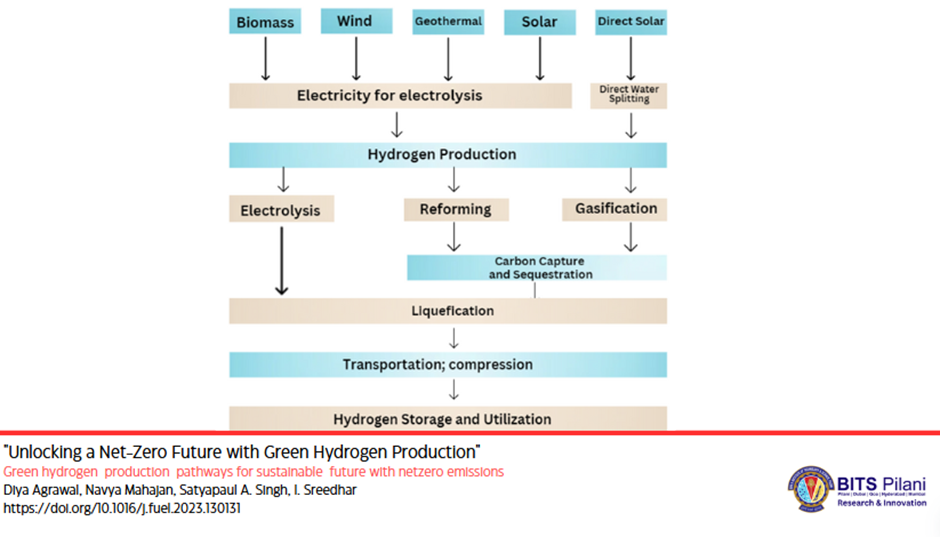Researchers like Diya Agrawal, Navya Mahajan, Satyapaul A. Singh, and I. Sreedhar, delves into the innovative pathways for producing green hydrogen, focusing on advanced electrolysis and photocatalysis methods with a specific emphasis on alkaline water electrolysis (AWE), proton exchange membrane electrolysis (PEME), and solid oxide electrolysis cells (SOEC). The study highlights the challenges and potential solutions for efficient and economically feasible water electrolysis, including the need for effective catalysts. It also explores the use of photocatalysis to enhance hydrogen production efficiency. The study focuses on comprehensive overview of the current technologies and materials used in green hydrogen production and discusses the future prospects and challenges in this field and also an alternative renewable energy sources for hydrogen generation.
Key Insights
- Transition metal-based catalysts for hydrogen production show promise but face challenges in industrialization and commercialization.
- Multiscaling design and fabrication approaches are needed to improve durability and electrocatalytic activity of transition metal-based catalysts.
- Biomass and solar energy are alternative renewable sources for hydrogen production, but efficiency and cost-effectiveness are still challenges.
- Storage and transportation methods for hydrogen, such as compressed gas, liquid, pipeline, and organic liquid carriers, are being explored.
- Hydrogen utilization in fuel cells, particularly in fuel cell electric vehicles and heavy-duty trucks, shows promise for a clean and sustainable energy future.
Considering the current state of the world's climate and the ongoing energy revolution, hydrogen energy is very necessary for the construction of a sustainable civilization that produces zero net carbon emissions. The majority of Power-to-X methods, which will influence the future energy market, are the starting point for hydrogen generation. Electrolysis systems that generate hydrogen through the use of water or steam each have their own set of advantages and disadvantages. When it comes to producing hydrogen, the most common ways of water splitting that are utilized are electrolysis and photocatalysis. In this study, these technologies, as well as their potential and potential challenges in the future, are discussed. While the research shows that Alkaline Water Electrolysis (AWE) is a commercial technology that is capable of producing hydrogen on a large scale, the literature also claims that Proton Exchange Membrane Electrolysis (PEME) and Solid Oxide Electrolysis Cells (SOEC) are an extremely efficient method of producing hydrogen. A number of obstacles stand in the way of water electrolysis that is both economically feasible and energy efficient. In order to improve the efficiency of the Hydrogen Evolution Reaction (HER) and the Oxygen Evolution Reaction (OER), it is necessary to have catalysts that are both effective and long-lasting. This article has a table that lists the different categories of electrocatalysts. In comparison to noble metal catalysts like IrO2, RuO2, Pt, and Pd, transition metal catalysts are not only more cost-effective but also just as effective. Additionally, it draws attention to the difficulties associated with the manufacturing and commercialization of electrocatalysts and offers potential solutions. A discussion of photocatalysis as an effective approach for the production of hydrogen is included in the second half of the study.
Moreover, it describes photocatalysts that have been created to improve the efficiency of hydrogen production. The photocatalytic water splitting activity of pure photocatalysts can be improved through the manipulation of shape, the addition of cationic or anionic doping, the fabrication of heterojunctions or nanocomposite structures, and the production of defects. In addition to that, the research discusses various unconventional renewable energy sources that can be used to generate hydrogen.
The many methods of producing hydrogen that are less harmful to the environment are being presented and discussed in this study. In addition to this, it provides an overview of the many features, including storage, electrocatalysts, and photocatalysts. A significant amount of attention has been paid in recent years to the utilization of hydrogen as a fuel due to the fact that it has a high calorific value and produces no net carbon emissions. Electrolysis and photocatalysis are two methods that have been thoroughly researched as potential methods for the production of hydrogen. After reviewing the relevant literature, it has been determined that the three primary types of electrolysis require additional research in order to be utilized on a broad basis. Industrialization and commercialization are the most significant difficulties that need to be solved, despite the fact that there has been significant progress made in the electrocatalysts that are being used. The production of hydrogen by photocatalysis is a novel technological approach that is safe for the environment. Researchers, on the other hand, need to concentrate their efforts on improving the catalytic activity of photocatalysts. It is necessary to conduct additional research in order to lower the cost of producing hydrogen from RSE. In conclusion, technological developments in the field of hydrogen storage and transportation would guarantee efficient exploitation of the hydrogen that is produced.


 An Institute of Eminence
An Institute of Eminence








